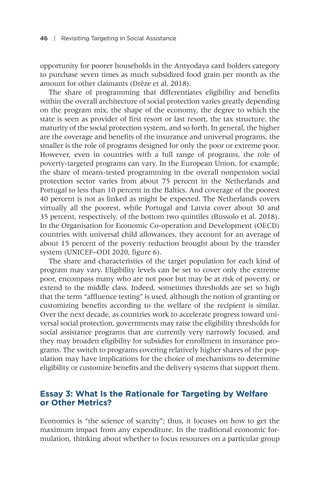46 | Revisiting Targeting in Social Assistance
opportunity for poorer households in the Antyodaya card holders category to purchase seven times as much subsidized food grain per month as the amount for other claimants (Drèze et al. 2018). The share of programming that differentiates eligibility and benefits within the overall architecture of social protection varies greatly depending on the program mix, the shape of the economy, the degree to which the state is seen as provider of first resort or last resort, the tax structure, the maturity of the social protection system, and so forth. In general, the higher are the coverage and benefits of the insurance and universal programs, the smaller is the role of programs designed for only the poor or extreme poor. However, even in countries with a full range of programs, the role of poverty-targeted programs can vary. In the European Union, for example, the share of means-tested programming in the overall nonpension social protection sector varies from about 75 percent in the Netherlands and Portugal to less than 10 percent in the Baltics. And coverage of the poorest 40 percent is not as linked as might be expected. The Netherlands covers virtually all the poorest, while Portugal and Latvia cover about 30 and 35 percent, respectively, of the bottom two quintiles (Bussolo et al. 2018). In the Organisation for Economic Co-operation and Development (OECD) countries with universal child allowances, they account for an average of about 15 percent of the poverty reduction brought about by the transfer system (UNICEF–ODI 2020, figure 6). The share and characteristics of the target population for each kind of program may vary. Eligibility levels can be set to cover only the extreme poor, encompass many who are not poor but may be at risk of poverty, or extend to the middle class. Indeed, sometimes thresholds are set so high that the term “affluence testing” is used, although the notion of granting or customizing benefits according to the welfare of the recipient is similar. Over the next decade, as countries work to accelerate progress toward universal social protection, governments may raise the eligibility thresholds for social assistance programs that are currently very narrowly focused, and they may broaden eligibility for subsidies for enrollment in insurance programs. The switch to programs covering relatively higher shares of the population may have implications for the choice of mechanisms to determine eligibility or customize benefits and the delivery systems that support them.
Essay 3: What Is the Rationale for Targeting by Welfare or Other Metrics? Economics is “the science of scarcity”; thus, it focuses on how to get the maximum impact from any expenditure. In the traditional economic formulation, thinking about whether to focus resources on a particular group


